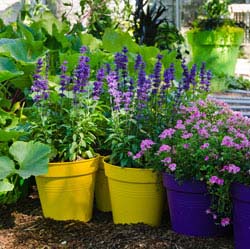Quick Digs: Treating Salvias as Bedding Plants

As autumn days become shorter, so does time for protecting all your tender perennial sages (Salvia spp.) that nature designed for warmer winter conditions.
This is the fifth and final article in our Quick Digs series on preparation for winter in the Salvia garden. Each Quick Digs selects a central issue about gardening and provides a number of brief articles suggesting ways to deal with the issue.
This post acknowledges that it isn't always possible or even preferable to overwinter tender perennial sages. Sometimes it is better to replant favorites as annuals in spring.
Chilly Houseguests
Although some of your sages may be unlikely to survive the winter temperatures of the local USDA Plant Hardiness Zone, you may not have the time, materials or energy necessary to mulch, wrap, cover and otherwise protect them outdoors.
Bringing outdoor plants indoors may be equally awkward. This is especially true if your home is short on sunny windows and rooms suitably cool for species meant for chilly -- but not freezing -- outdoor temperatures during winter in moderate climates. Cool temperatures allow tender perennials to slow down and rest during winter.
If you have an unheated sun porch or are accustomed to setting your thermostat to a bracing 50 degrees F at night, then tender perennials may not seem like demanding houseguests. Otherwise you may be tempted to move the pots out to the garage. Yet even if the temperature in your garage stays above freezing, it may also be a difficult spot for storage if space is limited.
But unless you are on a tight budget or are growing a rare sage that is difficult to obtain, you don't always have to go into rescue mode.
In fact, many favorite plants that people only know as bedding choices -- such as snapdragons and zinnias -- are tender perennials elsewhere. In zones outside their comfortable winter range, these plants sometimes survive freezing weather in-ground if grown along a sunny brick wall or in another relatively warm spot.
Food for Birds and Soil
Many gardeners remove annuals after frost arrives and add them to the compost heap. Others leave their plants in place so songbirds can feast on the seeds that form if you don't deadhead flowers near the end of the growing season.
Over time, dead plants enrich the soil by decomposing. Fallen leaves and broken stems are good food for earthworms, which help turn organic litter into humus. So leaving favorite tender perennial Salvias outdoors to meet their winter fate can be beneficial for small creatures and soil.
As winter winds blow and as birds accidentally drop seeds, some of your sages may live on to germinate in spring. This doesn't always occur, but certain sages have a reputation for coming back year after year by self-seeding. These include Cedar Sage (Salvia roemeriana), Mealy Cup Sage (Salvia farinacea), Giant Brazilian Sage (Salvia subrotunda) and Tropical Sage (Salvia coccinea).
Of course, the seed of hybrid cultivars most likely won't produce offspring that look exactly like their parent plants, but volunteer seedlings are fun surprises.
Renovations and Reservations
If you enjoy changing the look of your gardens every year, growing tender perennial sages as bedding plants offers opportunities for renovation.
However, another choice is possible if you have reservations both about spending on annuals and investing effort in winter preperation. That option is to plant only sages and other perennials that are rated as being cold hardy to your local zone. Remember though, if a winter is unusually severe, some plants zoned for your region may not survive.
Reruns and Requests
If you would like to re-read the previous four articles in this series, here they are:
- Prepping and Overwintering in Salvia Gardens
- Putting Salvias to Bed with Winter Mulch
- Overwintering Salvias in Containers Outdoors
- Overwintering Salvias Indoors
To request more information about your zone and sages that are wise choices for its climate, please feel free to contact us. We'll be glad to help you dig into the subject.

 Salvia roemeriana
Salvia roemeriana  Salvia splendens van houttei 'Elk Giant Orange'
Salvia splendens van houttei 'Elk Giant Orange'  Salvia VIBE® 'Ignition Fuchsia'
Salvia VIBE® 'Ignition Fuchsia'  Salvia VIBE® 'Ignition Purple'
Salvia VIBE® 'Ignition Purple'  Salvia VIBE® 'Ignition White'
Salvia VIBE® 'Ignition White'  Salvia dichlamys x microphylla 'Elk Red-Violet'
Salvia dichlamys x microphylla 'Elk Red-Violet'
Comments
There are no comments yet.